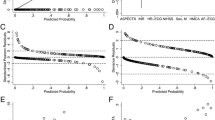Abstract
Background
The National Institutes of Health Stroke Scale (NIHSS) is able to predict mortality and functional outcome in patients with ischemic stroke. Its role in primary intracerebral hemorrhage (ICH) is not clear. The objective of our study was to investigate whether NIHSS is a reliable instrument of clinical monitoring and correlates with mortality and functional outcome in ICH.
Methods
One hundred fifty-six consecutive subjects with primary ICH were included. We evaluated NIHSS at admission. The functional state after a 30-day and a 3-month-long follow-up was assessed by the modified Rankin Scale (mRS). Spearman’s rank correlation coefficient analysis was used for statistics. Sensitivity, specificity, positive predictive value, negative predictive value, global accuracy, and ROC curve were computed using the median score 7 as NIHSS cutoff and the score 4 as mRS cutoff.
Results
Median NIHSS score at admission was 7 (16–4); the mean (± SD) was 10.82 (± 8.27). Thirty-two patients (20.5%) died within 30 days and other 22 (14.1%) within 3 months. The median mRS score at 3 months was 4 (6–1); the mean (± SD) was 3.38 (± 2.42). We found a statistically significant correlation between initial NIHSS score and mRS score after 30 days (0.74) and 3 months (0.66, p < 0.01). Sensitivity was 93.5 and 92.2%, specificity 82.3 and 69.6%, and GA 87.8 and 80.8%, respectively, at 1 and 3 months. The 1- and 3-month ROC curves comparing initial NIHSS and mRS showed a fitted area as 0.914 and 0.833, respectively.
Conclusions
NIHSS is a reliable tool of clinical monitoring and correlates with 30-day and 3-month mortality and functional outcome in subjects with ICH.


Similar content being viewed by others
References
Caplan LR (1992) Intracerebral haemorrhage. Lancet 339:656–658
Kay R, Woo J, Kreel L, Wong HY, Teah R, Nicholls MG (1992) Stroke subtypes among Chinese living in Hong Kong: the Shatin Stroke Registry. Neurology 42:985–987
Dennis MS (2003) Outcome after brain haemorrhage. Cerebrovasc Dis 16(Suppl 1):9–13
Ikram M, Wieberdink RG, Koudstaal PJ (2012) International epidemiology of intracerebral hemorrhage. Curr Atheroscler Rep 14:300–306
Morgenstern LB on behalf of the American Heart Association Stroke Council and Council on Cardiovascular Nursing (2010) Guidelines for the management of spontaneous intracerebral hemorrhage: a guideline for healthcare professionals from the American Heart Association/American Stroke Association. Stroke 41:2108–2129
Stroke Unit Trialists' Collaboration. Organised inpatient (stroke unit) care for stroke. Cochrane Database of Systematic Reviews 2013, Issue 9. Art. No.: CD000197. https://doi.org/10.1002/14651858.CD000197.pub3
Ovesen C, Havsteen I, Rosenbaum S, Christensen H (2014) Prediction and observation of post-admission hematoma expansion in patients with intracerebral hemorrhage. Front Neurol 5. https://doi.org/10.3389/fneur.2014.00186
Yu Z, Zheng J, Ma L, Guo R, Li M, Wang Z, Lin S, Li H, You C (2017) The predictive accuracy of the black hole sign and the spot sign for hematoma expansion in patients with spontaneous intracerebral hemorrhage. Neurol Sci 38:1591–1597
Cheung CM, Tsoi TH, Hon SFK, Au-Yeung M, Shiu KL, Lee CN, Huang CY (2008) Using the National Institutes of Health Stroke Scale (NIHSS) to predict the mortality and outcome of patients with intracerebral haemorrhage. Hong Kong Med J 14:367–370
Brouwers HB, Goldstein JN (2012) Therapeutic strategies in acute intracerebral hemorrhage. Neurotherapeutics 9:87–98
Davis SM, Broderick J, Hennerici M, Brun NC, Diringer MN, Mayer SA, Begtrup K, Steiner T (2006) Recombinant activated factor VII intracerebral hemorrhage trial investigators. Hematoma growth is a determinant of mortality and poor outcome after intracerebral hemorrhage. Neurology 66:1175–1181
Demchuk A, Dowlatshahi D, Rodriguez-Luna D, Molina CA, Blas YS, Dzialowski I, Kobayashi A, Boulanger JM, Lum C, Gubitz G, Padma V, Roy J, Kase CS, Kosior J, Bhatia R, Tymchuk S, Subramaniam S, Gladstone DJ, Hill MD, Aviv RI, for the PREDICT/Sunnybrook ICH CTA study group (2012) Prediction of haematoma growth and outcome in patients with intracerebral haemorrhage using the CT-angiography spot sign (PREDICT): a prospective observational study. Lancet Neurol 11:307–314
Vespa P, McArthur D, Miller C, Hirt D, Etchepare M (2005) Frameless stereotactic aspiration and thrombolysis of deep intracerebral hemorrhage is associated with reduction of hemorrhage volume and neurological improvement. Neurocrit Care 2:274–281
Wang WZ, Jiang B, Liu HM, Li D, Lu CZ, Zhao YD, Sander JW (2009) Minimally invasive craniopuncture therapy vs. conservative treatment for spontaneous intracerebral hemorrhage: results from a randomized clinical trial in China. Int J Stroke 4:11–16
Hemphill JC 3rd, Bonovich DC, Besmertis L, Manley GT, Johnston SC (2001) The ICH score: a simple, reliable grading scale for intracerebral hemorrhage. Stroke 32:891–897
Rost NS, Smith EE, Chang Y, Snider RW, Chanderraj R, Schwab K, FitzMaurice E, Wendell L, Goldstein JN, Greenberg SM, Rosand J (2008) Prediction of functional outcome in patients with primary intracerebral hemorrhage: the FUNC score. Stroke 39:2304–2309
Author information
Authors and Affiliations
Corresponding author
Ethics declarations
Conflict of interest
The authors declare that they have no conflict of interest.
Ethical approval
All procedures performed in studies involving human participants were in accordance with the ethical standards of the institutional and/or national research committee and with the 1964 Helsinki declaration and its later amendments or comparable ethical standards. Informed consent was obtained from all individual participants included in the study.
Rights and permissions
About this article
Cite this article
Finocchi, C., Balestrino, M., Malfatto, L. et al. National Institutes of Health Stroke Scale in patients with primary intracerebral hemorrhage. Neurol Sci 39, 1751–1755 (2018). https://doi.org/10.1007/s10072-018-3495-y
Received:
Accepted:
Published:
Issue Date:
DOI: https://doi.org/10.1007/s10072-018-3495-y




